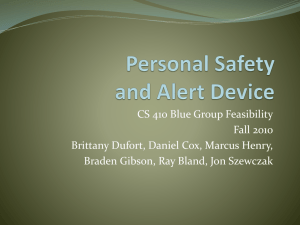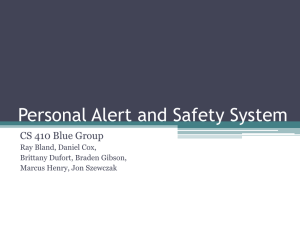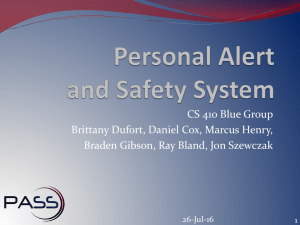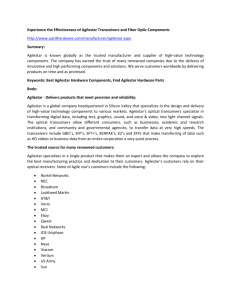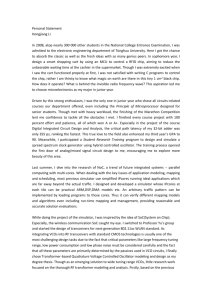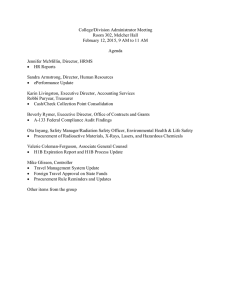CS 410 Blue Group Brittany Dufort, Daniel Cox, Marcus Henry, 26-Jul-16
advertisement
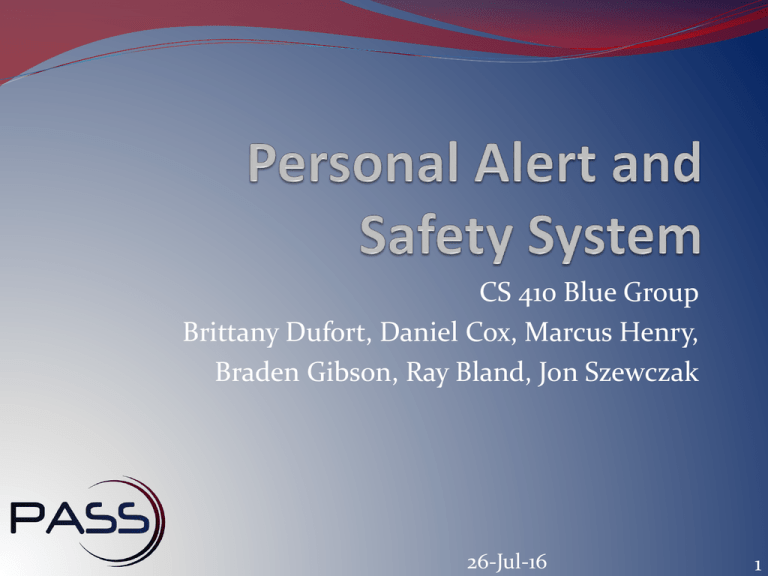
CS 410 Blue Group Brittany Dufort, Daniel Cox, Marcus Henry, Braden Gibson, Ray Bland, Jon Szewczak 26-Jul-16 1 Gene Price General Manager Brittany Dufort Project Manager Marcus Henry Hardware Development, Financial Braden Gibson Daniel Cox Web Developer Software Development, Outreach/Consulting Communications Expert Ray Bland Database Support, Outreach/Consulting Networking Expert 26-Jul-16 Jon Szewczak Hardware Development, Financial Emergency Services Consultant 2 Background In times of need people call 9-1-1 for emergency assistance. Personal Crimes (i.e. Robberies, Assaults) Accidents and/or Injuries Existing security paradigms rely on verbal communication with people in need – which usually comes after the event has occurred. During a personal crime the victim often cannot call 91-1 for fear of aggravating the assailant. 26-Jul-16 3 Response Time U.S. Department of Justice Office of Justice Programs Bureau of Justice Statistics http://bjs.ojp.usdoj.gov/content/pub/pdf/cvus07.pdf Page 115, Table 107 26-Jul-16 4 Societal Need In the event of a personal crime or emergency, security professionals at higher education, business and civil complexes need an effective way to allow individuals to quickly and silently communicate their location to first responders. 26-Jul-16 5 Proposed Solution Individuals would be equipped with a key fob. Pressing a button or combination of buttons would trigger an alert at a security dispatch center. The alert would be repeated every 30 seconds until first responders reset the unit. 26-Jul-16 6 Benefits of Solution Aids in improving response time First responders do not need location information from victims. Victims do not have to fumble around for a cell phone and dial a number; a button push is all that is required to summon aid. If the victim is moving (i.e. on the run), the system will report their movement. Based on proven technology. Could act as a deterrent. 26-Jul-16 7 Determining Customer Many possible customers: Universities or Colleges Business complexes (i.e. Google, Microsoft, Intel, Trump Tower) Civil complexes (i.e. the Capitol Building) Scoping Issues Due to time constraints the focus will be on Universities. In particular Old Dominion University 26-Jul-16 8 Old Dominion University Spends approximately a $262,000.00 on security every year. Personnel, Security Devices, etc. In 2008 10 personal crimes on campus 2 in residence halls 4 off campus 46 in the surrounding neighborhoods That averages 1 crime per week for the entire year. 26-Jul-16 9 Old Dominion University Refer to the handout to match up locations with crime descriptions. 26-Jul-16 10 Old Dominion University The interest in the concept is very high. A few weeks ago, two team members met with ODU Police officials, and were surprised at the eagerness that was displayed. There would be very little financial return on investment. However, the ability to make students, staff, and faculty a little safer could be considered an adequate return. 26-Jul-16 11 Hardware Milestones Phase 1 Duration Prototype Create Unique KeyFob Address(es) Modifying Transceivers for Task Modify Master Receiver for Task 12 Days 3 Days 4 Days 2 days Testing Signal Strength of KeyFobs Testing at Various Locations 15 Days 2 Days 3 days Ensure Location Algorithm Correctness 7 Days 26-Jul-16 12 Software Milestones Phase 0 and 1 GUI – 1 month 2. Base Software – 3 months 1. 2.1 2.2 Transceiver Software Fob software 3. Database – 3 days 4. Drivers – 2 weeks 26-Jul-16 13 Software Milestones Critical Design – Phase 2 2.1 Develop GUI 2.1.1 Menus 2.1.2 Map Display 2.1.2.1 Develop interactive display 2.1.3 Database View 2.1.3.1 Develop interactive display 2.1.4 Develop Color Scheme and Layout 2.2 Develop Base Software 2.2.1 Develop Software to Receive signal from key fob 2.2.2 Develop Software to send signal from fob to base Station 2.2.3 Develop Triangulation Algorithm 2.2.4 Develop map implementation from given location 2.3 Develop Database 2.4 Develop Drivers 26-Jul-16 14 Software Milestones Phase 3 and beyond 1. Update software based on location/Organization 2. Basic Updates for bugs/fixes 26-Jul-16 15 Work Breakdown Schedule - Phase 0 26-Jul-16 16 Work Breakdown Schedule - Phase 1 26-Jul-16 17 Work Breakdown Schedule - Phase 2 26-Jul-16 18 Work Breakdown Schedule - Phase 2 (cont’d) 26-Jul-16 19 Work Breakdown Schedule - Phase 3 26-Jul-16 20 Technical Aspects Radio based Key fob alert units (approx. 100’ range). Transceivers stationed to give maximum coverage to the most logical areas (approx. 330’ range). Relay Transceivers A master receiver which would interface with the GUI at a dispatch station. A software suite (most likely based on the Google Maps API) to provide a GUI for dispatch stations. 26-Jul-16 21 Process Flow Diagram Through a series of transceivers that signal would be translated to dispatch. When a fob button(s) is pushed a signal would be sent out. The dispatch station will have a graphic user interface that maps the location of the emergency beacon. Once activated the fob would automatically repeat its broadcast until reset by responders. Dispatch would route a responder at a high priority to assess the situation. 26-Jul-16 22 Data Flow Diagram Relay to another transceiver Key Fob Signal Sent Wired Power Long Range Wireless Transceiver Signal Received Control Unit Master Receiver Server Decodes Received Message Packet Queries Database Triangulates Position Wireless Transceiver Signal Transmitted Prefix Appended If None Exists No In Range of Master Receiver Yes Database 26-Jul-16 Graphic User Interface Location of Signal Data About User 23 Database Schema 26-Jul-16 24 Data Representation 26-Jul-16 25 Sample GUI 26-Jul-16 26 Sample GUI 26-Jul-16 27 Sample GUI 26-Jul-16 28 Pricing Model Base Package – $220,000 Installation Support Survey of Complex and Recommended Transceiver Locations 5,000 Transceivers 3,000 Fobs 1 Master Receiver All Software 26-Jul-16 29 Pricing Model (cont’d) Optional Packages Additional Fobs (1,000 each) - $25,000 Additional Transceivers (1,000 each) - $22,000 Maintenance and Support - $25,000 per year All software upgrades, fixes and patches included. Faster response time for support correspondence. 26-Jul-16 30 Pass Costs Based on Pricing Model Fobs $20 (1) Transceivers $22 Board $16 (2) Enclosure $5 (3) Battery $1 Master Receiver $50 - $100 Software Development $200, 000 (Rough Order of Magnitude) TOTALS Base Package $370,000 Additional Fobs $20,000 Additional Transceivers $25,000 1. http://www.sparkfun.com/commerce/product_info.php?products_id=8602 2. http://www.sparkfun.com/commerce/product_info.php?products_id=705 3. http://www.alibaba.com/product-gs/35770158/outdoor_weatherproof_enclosure.htm 26-Jul-16 31 ODU Costs Based on Pricing Model $220,000 $66,000 $50,000 + $25,000 $361,000 Base Package Additional Fobs – 3 @ $22,000 Additional Transceivers – 2 @ $25,000 1 Year Maintenance & Support 4,500 Students Living on Campus (approximately) 1,600 Faculty and Staff (optional) 6,100 Population (estimated Max) The number of Transceivers Depends on the Desired Coverage Area (estimate 7,000 total receivers). 26-Jul-16 32 Competition Handheld Device Expandable Long Range PASS Safety Alarms Centurion Guardian Medical Alert Alarms a a a a a Silent Alarm Location Info a a a a r r r r a* a** a a** r a r r r a*** a a * With vendor assistance only and requires software upgrade ** Maximum number of repeaters (300) limits coverage area *** Only if preprogrammed messages include a location 26-Jul-16 33 Risk Matrix 26-Jul-16 34 Risk Management Financial Technical Legal Possible Misuse / Deviant Usage 26-Jul-16 35 Financial Risks There is a substantial initial outlay Potential recovery of costs for customers is marginal Project puts emphasis on safety and not commercial viability Unless hardware costs can be controlled, the system may preclude smaller institutions. Setting up transceivers may need a large labor force. Possibility of running into Unions 26-Jul-16 36 Financial Management The system is expensive, yet the clients we market to have ways of helping to offset this cost. Old Dominion University has an annual tuition rate that incurs for every student. Part of this fee goes towards campus safety. In terms of budgetary oversights, we plan to have SBIR funding in the grants section. This along with outside investment should allow some leeway for budget constraints. 26-Jul-16 37 Financial Management Staffing is an issue, and we will have to work with unions when the time comes for installation. Virginia is a right-to-work state therefore unions will not constrain our venture. The recurring cost issue is one that only comes up when new employees or students matriculate to the university or complex. The initial system itself (the transceivers) is already intact. Therefore recurring costs will not be as high as the initial outlay and can easily be covered by tuition or new employee safety fees. 26-Jul-16 38 Technical Risks FCC Guidelines / Licenses Possible interference from other broadcasting devices (i.e. cell phones, baby monitors, etc.) Mitigated by proven radio technologies There is also a probability that hackers or trouble makers may find ways to use our system aside from its proper function. Another issue is that our system will rely on signal propagation or piggybacking and it may be hard to find technical experts to help on this venture. 26-Jul-16 39 Technical Mitigation The FCC has information readily available online about what frequencies are available to businesses. As can be seen from our milestones, we will test what frequencies our system is able to use and run it by the FCC for approval. The issue of radio interference is another aspect of our milestones, while testing the frequencies we will make sure that they do not interfere with other businesses. It is always possible for people to find ways to achieve mischief; as such we will make sure that the signals sent out by our fobs are encrypted so that only our transceivers will pick them up for transmission relay. We believe that the use of Old Dominion University professors well versed in signal processing and transmission will enable our project to move forward with the aforementioned transmission methods. 26-Jul-16 40 Legal Risks Device fails to send an alert to the monitoring authority – introduces possible liability issues 26-Jul-16 41 Possible Misuse / Deviant Usage A lost alert device could be used by a criminal element to distract monitoring authorities from a real event. System is used to pull pranks, instead of alerting first responders to a real emergency. 26-Jul-16 42 Scope Since the project is very large, it will have to be broken down into a more manageable chunk. Customer – Old Dominion University Hardware – a working prototype communicating with software Software – a working GUI interface for mapping the location of the alert 26-Jul-16 43 Questions? 26-Jul-16 44
